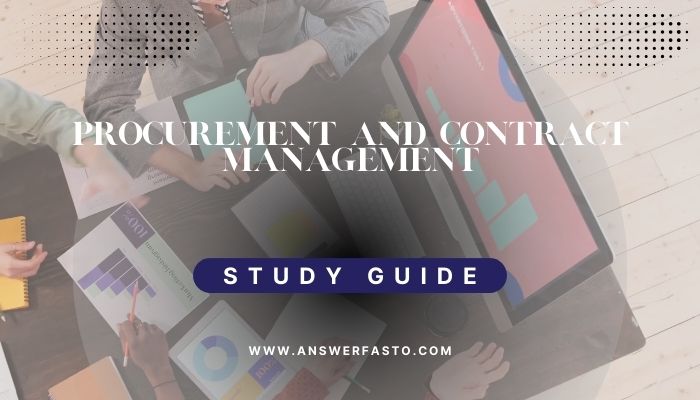Acquisition and Contract Management is an integral part of project management. This involves sourcing external goods, services works into a contract management process that facilitates successful project execution. Below are examples that describe the procurement processes, vendor selection, and contract management.
1.Procurement Process:
Identification of Procurement Needs: It is the most important thing that determines what goods or services should be procured with an indication of their specification, quantity, and quality.
Example: Construction project makes use of materials such as steel and cement along with equipment such as cranes.
2. Plan Procurement:
It is the availability of procurement strategy concerning methods (for instance through competitive bidding or direct negotiations) budget allocation, and potential vendors for procuring goods and services.
Example: An IT project may prepare a Request for Proposal to engage Software vendors.
3. Vendor Selected:
Assessment of what the vendor’s capabilities will include supply strengths or weaknesses, and whether the firm has extensive financial, technical, or infrastructure capabilities; looking at references provided and verifying their claims about the services and products they offer. How RFIs and RFQs would help assess the context.
Example: A company looking for office furniture compares the competitors with respect to price, quality, and time of delivery.
In these, I would say you have:
4. Contract Negotiation:
Finalization of the specific terms of pricing, payment schedule, warranties, etc., in the detailed discussions with the selected vendor.
Example: For example, in a software project terms would include scope, intellectual property rights, milestone payments, etc.
5.Contract Award:
Sign the contract with the chosen vendor after negotiations to formalize the agreement.
Example: Awarding a government road construction contract would be after bid evaluations.
6. Contract Administration:
Ensure the vendor’s compliance with the contract, manage all changes, and prepare for any dispute resolution.
Example: A project manager makes sure of deadlines and quality standards for an agency before it closes the deal.
7. Contract Closure:
All deliverables have been made, payments completed, and the remaining obligations met.
Example: The event management company will close the contract after returning rented equipment and settling the bill.
Contract Management Activities
1. Contract Monitoring:
Measure and track vendor company performance according to their limits from their deliverables.
Example: Call center service responses from an outsource regarding their quality.
2. Change Management:
Recording changes and subsequent negotiations are to be applied whenever the contract modification is needed in terms of scope, time, or money.
Example: It can be that the clients have updated the specifications of output as per the manufacturing project and therefore amended a contract with the supplier.
3. Issue Resolution:
Is there a dispute or delay? Immediately arrange open communication and mediation to address the situation.
Example: Solutions provided to software project delays noted in identifying known bottlenecks with vendors.
4. Performance Evaluation:
Regular assessment of the vendor’s performance to assure value and also to know areas needing improvement.
Example: Evaluation of the training provider by participant feedback and adherence to schedule.
5. Contract Renewal or Termination:
Deciding against the renewing or terminating of the contracts involved looking at the performance and project needs.
Example: Terminating a supplier’s contract because of the repeated delays and the shoddy support given to its customers.
1. Singling out probable vendors
Researching potential suppliers usually involves searching for supplier-related entries in a directory of an industry they operate or deriving contacts via referrals or events and conferences.
Typical scenario: The software developmental house would get the best vendors by visiting from an exposition or searching online databases.
2. Prequalification:
Prequalify Vendor for Financial Soundness, Skill Level, and Capability on Requirements
Example: The construction company may depend on financial statements or project portfolio.
3. Request for Information (RFI):
Collect all information regarding a vendor’s benefit concerning objectives of project achievement.
Defined example: A manufacturing group may set up a partnership in seeking freight supplier information reliability and delivery capacity.
4. Request for Proposal (RFP):
Solicit proposals and requests from qualified vendors to present their entire offers, including the proposed solutions and price.
For example: an RFP may be issued by an IT project, documenting the specifications of the system and timelines for delivery.
5. Vendor Evaluation and Selection Process:
A scoring mechanism or presentation can then be deployed to collate applications in evaluating the submissions and, so, identify the best fit.
For example: a marketing project may want to evaluate advertisement agencies on creativity, budget, and success of past campaigns, and all can be put into the context of evaluation criteria.
6. Contract Negotiation:
Negotiate and confirm the terms of the contract to satisfy both the parties.
For example: A consulting project would be characterized by the negotiation of fees, deliverables, and confidentiality terms.
Contract administration
1. Implementation:
Share all contract details with all stakeholders to achieve clarity of the roles and responsibilities.
Example: Communicating milestones and reporting requirements to contractors by a project manager.
2. Performance Monitoring:
Regular review of the work done by the vendor based on timelines, quality benchmarks, and service levels.
Example: Moving ahead with tracking an IT vendor’s response time and bug resolution rates.
3. Change Management:
Cognize and adjust the changes required in the contract.
Example: Modifying a manufacturing contract to reflect the updated production schedule.
4. Issue Resolution:
Mutual problem resolution, possibly with engaging in legal escalation if required.
Example: Mediating design disputes in a construction project.
5. Monitoring of Compliance:
Comply with all terms of the contract, including legal and quality standards.
Example: Evaluate a supplier’s compliance with safety regulations on a health project.
6. Performance Evaluation:
Conduct reviews to provide feedback and determine future partnerships.
Example: Reviewing a vendor regarding their timeliness, quality, and communication after project completion.
In this way, by managing procurement and contracts well, project teams can manage any resource requirements, thus ensuring that vendors meet what is expected of them and making sure that all those ventures are aligned to project objectives and finally successful.



